Remember the Hubble Mystery Object? In 2006 it steadily brightened, then steadily faded over the course of 200 days total, in a way that resembled no known type of variable object. Even its spectrum was inscrutable, leaving no sign of whether it was a flare on a very faint star in our own Milky Way or some enormous eruption billions of light-years distant.

Now you don't see it, now you do. Something truly in the middle of nowhere — apparently not even in a galaxy — brightened by at least 120 times during more than three months and then faded away.
K. Barbary and others
Now there's a sign that it was the latter. And one new theory suggests that an odd, wandering, intergalactic black hole tore apart a star of unusual composition. But that idea seems forced, leaving astronomers still at a loss to explain all the features of the strange event.
The object, called SCP 06F6, was first spotted (in Bootes) in February 2006 during a Hubble Space Telescope search for far supernovae. The object rose to its maximum brightness in about 100 days, much longer than most supernovae take (usually about 20 days or less).
Analysis of the object's spectrum in 2008 offered no more clues: SCP 06F6 seemed to resemble no known object. Later, however, examining the spectrum over coffee, Boris Gaensicke (University of Warwick, U.K.) and colleagues noticed that dips in the spectrum looked familiar; they resembled molecular carbon absorption, but not at the normal carbon wavelengths. If this identification is correct, the object's light is redshifted by about 0.14, which places it about 1.8 billion light-years away.
Gaensicke and colleagues propose two scenarios that might explain the object. In one, a carbon-rich star swung too close to an intermediate-mass or heavyweight black hole, which pulled it apart. Some of the material made its way into the black hole, and some was blasted off in a flare that was seen from Earth as SCP 06F6.
Such star-swallowing flares brighten and dim with the same leisurely pace seen in SCP 06F6, and they also produce X-rays with a similar brightness to those the team was able to find at the location of the firefly-like event.
But so far, no one has found a galaxy or even a star cluster at the same place as the object, not even down to 26th magnitude, which argues against this scenario. Black holes do occasionally get slung out of their homes in galaxies during galaxy mergers, but "It would be very contrived to have a free-floating intermediate-mass black hole that would be disrupting a free-floating star in the intergalactic medium," says Gaensicke.
Another scenario is that the event was the supernova death of a massive star that had escaped to intergalactic space and that was swaddled in a region of carbon that the star itself had previously expelled, Gaensicke says. The shock wave from the blast would vaporize and heat the carbon, producing an event that could be as prolonged as SCP 06F6.
But massive stars are also unlikely to be found on their own. They live short lives, so they shouldn't have time to escape from their home galaxies.
And, the X-rays produced by SCP 06F6 were about 50 times brighter than those produced in the most luminous supernovae studied so far.
Best match?
The carbon spectral lines "are certainly the best match to the SCP 06F6 spectrum found so far," but they're not a perfect fit, says Kyle Barbary of the University of California, Berkeley, lead author of the 2008 paper on the object's discovery. "No possibility suggested so far is conclusive," he says.
Finding another example of the Hubble Mystery Object would be the next big step in figuring out what it was, Barbary says: "SCP 06F6 was found in a relatively small survey, so it is likely that there are a lot more of them out there. I'm quite hopeful that we will be able to find out the true nature of the event in the near future."
Gaensicke hopes one of Hubble's new cameras, the Wide Field Camera 3 (installed during last month's servicing mission) can spot signs of a small host galaxy around the object that was too faint to see with other instruments.
Here's the abstract of the new paper.
Courtesy NewScientist.com and other sources.
 0
0
Comments
You must be logged in to post a comment.